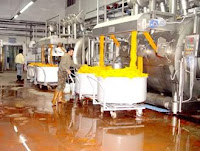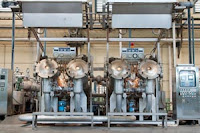Dyeing - Dyeing type
There are two main type of
transferring color onto fabrics: conventional and pigment dyeing.
Conventional dyeing
Conventional dyeing (or aqueous)
is a process that involves the usage of chemical dyestuffs and the treatment of
the fabric in water solutions
Pigment dyeing
Pigment dyeing is a process that
uses microscopic- sized, insoluble colored particles. In this method of dyeing,
pigments are mixed with a resin binder; which acts as an adhesive, and then
heated (curing) for the pigments to adhere to the fibers.
Dye stages
Dyeing can be done in various
stages of textile manufacturing,. The different stages are expalained below:
Solution dyeing
Solution dyeing is done in the
production stage of man-made fiber. Before the fiber is extruded through the
spinnerets, microscopic-sized colored pigments are added to the mixture during
its liquid form. Therefore, the fiber produced will be in the colored intended.
Fibers dyeing
Top dyeing is done during the
fiber stage, before it is spun into yarn. This is done by putting loose fibers
into large vats (dyeing containers) containing dyestuffs, which are then
heated. This type of dyeing is mostly used woolen (top is for worsted) material
to create heather effect (spinning two or more colored fibers)
Yarn dyeing
Yarn dyeing is the dyeing of
yarns before they are woven or knitted into fabrics. The purpose of yarn dyeing
is to create multicolored designs, such as plaids, stripes, checks, etc
The most common method for yarn
dyeing is usage of package dye. In this method, approximately 400 grams of yarn
is wound on a small perforated spool or tube. Many spools are fitted into a
dyeing machine in which the flow of the dye bath alternates from center out and
again from outside in. a min 50 kg and a max of 800 kg of yarns can be dyed at
one time by different sized machines.
Fabric dyeing
Piece dyeing is a dying process
after yarns have been woven or knitted into fabrics. In this dyeing process,
solid colored textile is achieved. The two most common methods of piece dyeing
is through the use of jet and jig dyeing machines.
In jet dyeing, fabric between
1000 to 2000 yards, in rope likes form, is dyed in a tensionless condition. The
fabric being dyed is circulated through the machine on a jet flow of dye bath.
In jig dyeing machine, smaller
amount of fabric can be dyed at one time. Between 50 to 100 yards. Fabric held by two rollers in an open width form
passes through the dye bath in the machine. Sometimes, fabrics that have been
jig dyed may have shading problem due to un even tension. The variation usually
occurs from center to the salvage of from end to end of the fabric
Garment dyeing
Garment dyeing is the dyeing of
complete garment (after sewing). In this process, garments are loosely packed
into a net bag and placed into a large tub containing dye bath.. a range of 10
to 50 nets bag can be dyed at the same time. Only non-tailored garments are
suitable for this type of dyeing.
Dye stuff
Color is an important attribute
in textile. It is by applying color to fabrics, that makes the textile products
more appealing to customers and more sellable. Color can be applied through
dyeing or printing of the fabric. The desire to color textiles is as old as
spinning and weaving. Natural coloring materials have been used for thousands
of years; mineral pigments such as yellow and red ochre, cinnabar; vegetable
dyes such as indigo, litmus, and logwood, madder, saffron; animal dyes such as
tyrian purple. Synthetic dyes first produced in the 19 th century and have now
almost completely replaced the natural colors. Dyeing material is called dyestuff
Colorfastness
Colorfastness means the resistance
of the color to various insults which textiles may suffer during manufacture
and use. Fastness depends on the type of dyestuff and the fiber substrate;
there is no universal color the same fastness on all substrates. Moreover,
different end uses have different fastness requirements; underwear has
different requirements from furnishings.
There are standardized of
evaluating the different type of fastness. The most important are:
Rubbing : resistance of the color
to rubbing, either wet or dry. Even the best dyeing, in every deep shade, may
lose some color in wet rubbing
Washing : the fastness to washing
determines the wash program which must be used by the consumer
Perpiration ; resistance to the
effects of respiration is important for underwear, outwear, and sport wear.
Colour may also be required to be
fast to light; weather, sea –water, solvents, ironing, etc. depend on the end
use of the final product.







